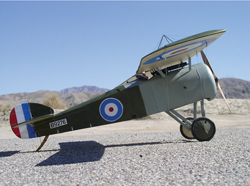Skill Level: Intermediate
FEATURES
- Scale number of flat bottomed ribs and sub ribs
- Balsa and plywood dummy motor
- Pull pull aileron linkages
HISTORICAL SIGNIFICANCE
From Wikipedia:
In June 1918, the Sopwith Aviation Company flew an unarmed parasol monoplane derivative of the Sopwith Camel, the Sopwith Monoplane No. 1, also known as the Sopwith Scooter. It used a normal Camel fuselage, with the wing mounted just above the fuselage, with a very small gap. The wing was braced using RAF-wires (i.e. streamlined bracing wires) to a pyramid shaped cabane above the wing. It was powered by a single 130 hp (97 kW) Clerget 9B rotary engine.
The Scooter, which was used as a runabout and aerobatic mount by Sopwith test pilot Harry Hawker, demonstrated excellent maneuverability, and formed the basis of a fighter derivative, originally the Monoplane No. 2, and later known as the Sopwith Swallow.
Like
the Scooter, the Swallow used the fuselage of a Camel, but it had a larger, slightly
swept, wing of greater wingspan and area, which was mounted higher above the fuselage
to allow the pilot to access the two synchronized Vickers machine guns. It was
powered by a 110 hp (82 kW) Le Rhône engine.
Operational history
The Swallow made its maiden flight in October 1918, and was delivered to RAF Martlesham Heath on 28 October 1918 for official testing. One possible role for the Swallow was as a shipboard fighter. Engine problems delayed testing of the Swallow, but when these problems were resolved, the Swallow proved to have lower performance than Le Rhône-powered Camels, and was discarded soon after testing was completed in May 1919.
The Swallow remained in use, and was given the civil registration K-135 in May 1919 (soon changed to G-EACZ). It was sold to Harry Hawker in April 1921, but was placed into storage when Hawker was killed in July. It was refurbished in 1925 and was used for aerobatic displays and for racing until 1927 when it was scrapped.
http://en.wikipedia.org/wiki/Sopwith_Swallow

